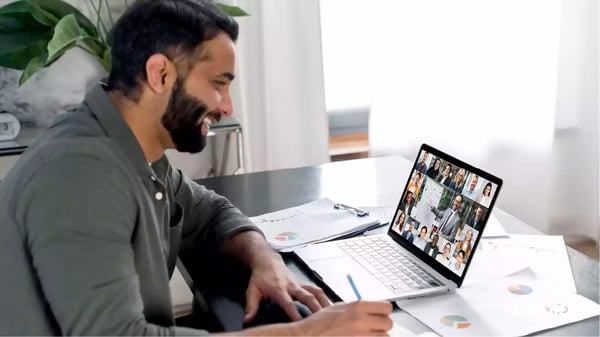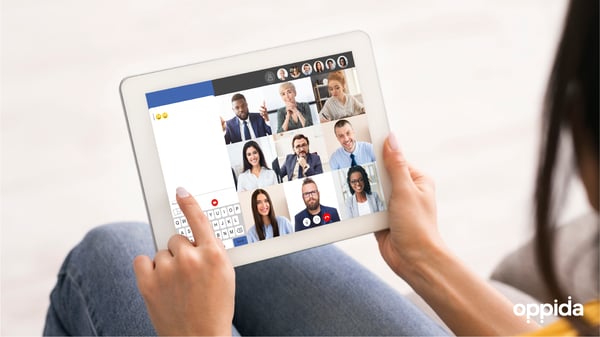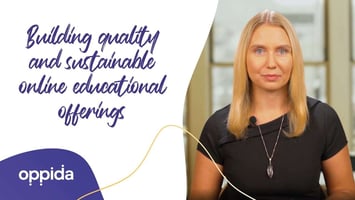Building quality online educational offerings
Oppida talks: Blended learning
In this Oppida Talks vlog, Oppida CEO Bianca Raby takes a practical look at blended learning. You’ll find more information about the subject below along with some suggested further reading.
Video Transcript
Hi. Today I want to talk about what blended learning really is. So blended learning, you can think of it a bit like pre-readings on steroids. So the idea is that in a blended learning experience you actually have synchronous engagements that are drawing upon asynchronous content. So that means live engagement, so anything where you are actually getting to interact with your learners in a real-time way, should be built upon the work that they are doing before they come into that learning experience. So a truly blended experience means that they have had an opportunity to engage with key concepts, some material beforehand, and they’ve done some preparation for when they come into the room, or the Zoom room, or whatever it is, with you and that’s when they can enhance their learning and learn from either the social connection or the connection with yourself or with the opportunity to ask questions. So, that is a true blended experience, and it can be face to face or online. So you can have an online blended experience because as long as you have a synchronous engagement opportunity where there is real-time feedback then it becomes a blended experience.
Defining “blended learning”
There has been a great deal of debate about defining “blended learning” but it’s generally agreed, at its simplest, to be a combination of face-to-face and technology-based (usually via internet) instruction and learning.
In The Handbook of Blended Learning: Global Perspectives, Local Designs, Charles Graham offers as a working definition: “blended learning systems combine face-to-face instruction with computer-mediated instruction.” (Bonk and Graham 2006 : 5)
In his 2019 review ‘What Do We Mean by Blended Learning?’, Stefan Hrastinski points out that the expression “blended learning” is both widely-used and ambiguous; that it covers “essentially all types of education that include some aspect of face-to-face learning and online learning”. There are multiple models and conceptual approaches, a variety of technologies and instructional methods, to the point that blended learning “has become an umbrella term that describes the use of technology in education”. (Hrastinski 2019)
When the focus of definition is solely on the delivery mode, this doesn’t take into account the variety of learning theories, let alone the many elements that can be incorporated in the design of a blended learning offering. Jared Carmen (2005) categorises the “key ingredients” of blended learning as: synchronous live events, online content for individual self-study, collaboration opportunities, assessments and reference materials that enhance learning retention and transfer.
In this Oppida talks video, Bianca places her focus on the blend of synchronous and asynchronous learning activities, rather than how they are delivered, suggesting that it is the opportunity for learners to engage with the material before coming together with the instructor/class that is the ‘secret sauce’ of blended learning.
Regardless of the definition, what’s important is whether blended learning delivers the goods for learners. What are the benefits to learners, and is blended learning effective?

Benefits of blended learning
Aside from the obvious cost benefits to education institutions, does blended learning deliver benefits to students?
The asynchronous/online components of blended learning gives learners the ability to learn at their own pace along with some flexibility of scheduling around other aspects of their lives. Learners are able to make more effective use of synchronous class/instructor opportunities by engaging with the provided learning material beforehand .
Online delivery offers improved access to education for those who are disadvantaged by more traditional, in-person delivery systems; however it may disadvantage those who have unreliable internet connections, limited technology or a poor study environment.
The structured nature of online tools gives learners a clear roadmap for their learning and what is expected of them, along with the ability to track their progress and test their knowledge. Along with that, effective use of data analytics gives instructors an opportunity to identify learners who are struggling or simply not devoting enough time to the material.

Effectiveness of blending learning
According to a 2009 US Department of Education study, “learning outcomes for students who engaged in online learning exceeded those of students receiving face-to-face instruction”, with ‘instruction combining online and face-to-face elements” having “a larger advantage relative to purely face-to-face instruction than … purely online instruction”. (Means et al. 2010 : xiv–xv)
Stein and Graham (2014) suggest some additional reasons for the effectiveness of blended learning, including the possibility that the instructional design is improved due to greater intentionality in the design process and the likelihood of the instructor being supported by instructional designers and education technologists. They also suggest that engagement may actually be increased through social interaction in well-designed and facilitated discussion and collaboration opportunities.

The future of blended learning
The events of 2020 and the consequent social distancing and lockdowns have resulted in much greater use of blended learning in schools and higher education. The quality of this learning has no doubt varied widely, from a continuation of a planned and thoughtful strategy at best through to an emergency dump of learning materials online at worst. A year on, research and publications are beginning to appear covering the experiences of both learners and instructors that will be valuable for informing the future development of blended learning models for higher education, workplace education and vocational training.

References
Bonk CJ and Graham CR (2006) The Handbook of Blended Learning: Global Perspectives, Local Designs, John Wiley and Sons, Inc, San Francisco
Carmen JM (2005) ‘Blended Learning Design: Five Key Ingredients’, accessed 8 April 2021
Hrastinski S (2019) ‘What Do We Mean by Blended Learning?’, TechTrends (63), 564–569 https://doi.org/10.1007/s11528-019-00375-5, accessed 8 April 2021
Means B, Toyama Y, Murphy R, Bakia M and Jones K (2010) Evaluation of Evidence-Based Practices in Online Learning: A Meta-Analysis and Review of Online Learning Studies, U.S. Department of Education Office of Planning, Evaluation, and Policy Development Policy and Program Studies Service, Washington
Stein J and Graham CR (2014) Essentials for Blended Learning: A Standards Based Guide excepted in Online & Blended Learning: Selections from the Field accessed at https://olc-wordpress-assets.s3.amazonaws.com/uploads/private/revision/Online-Blended-Learning-Selections-from-the-Field.pdf on 8 April 2021
Further reading
An effective blended online teaching and learning strategy during the COVID-19 pandemic
Blended learning is here to stay, but which aspects of digital teaching will universities keep?



